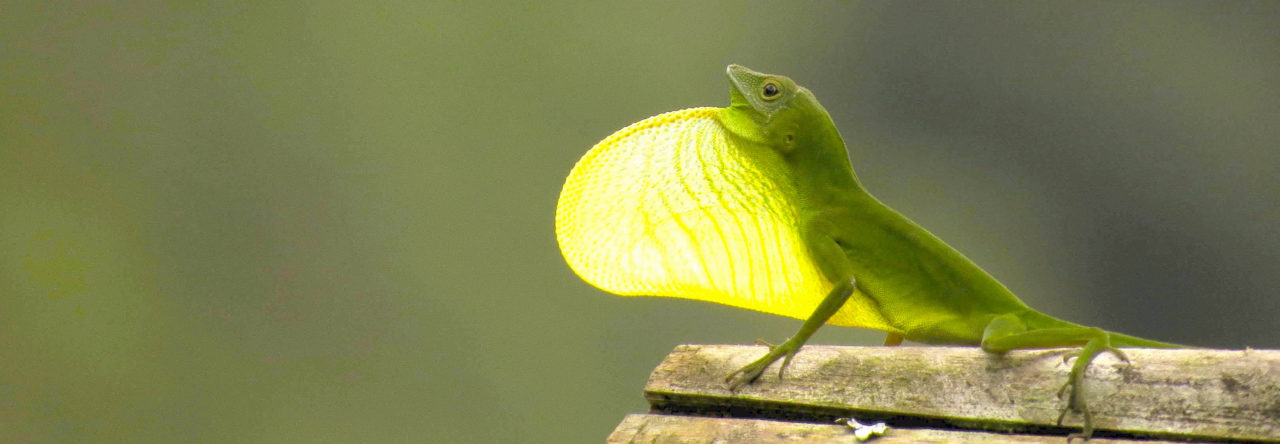
Anolis marmoratus, by Kristin Winchell. This photo is featured in the Anole Annals 2021 calendar!
Last year, Rafael Alejandro Lara Resendiz (Centro de Investigaciones Biológicas del Noroeste and Instituto de Diversidad y Ecología Animal) published a paper in Acta Biológica Colombiana, in which he summarizes nocturnal activities in exclusively diurnal reptiles and addresses the question of how this behavior affects their ecophysiology.
Ectotherms – reptiles, amphibians, fish, and most invertebrates – need environmental temperature to produce heat internally, meaning that these organisms depend upon an external source of heat to regulate their internal functions. Thermoregulation is a complex physiological process that is involved in every activity that allows ectotherms to survive in nature (e.g., feeding and reproductive behavior, growth patterns, locomotion, digestion). In this regard, ectotherm species differ in their thermoregulation behaviors; some species are more active during the day while others are active during the twilight. However, some species that are known to be diurnal have been found active during the twilight. Lara-Resendiz (2020) address four-point in his work. Specifically, he 1) reviews nocturnal activity events in reptiles considered exclusively diurnal; 2) discusses the ecophysiological implications on this topic; 3) identifies the aspects that have not yet been approached in-depth; and 4) proposes possible directions for future lines of research.
Several species that are known to be exclusively diurnal have been observed carrying out nighttime activities, including lizards (e.g., Agama, Anolis, Callisaurus, Dipsosaurus, Gerrhonotus, Liolaemus, Ophisaurus, Phrynosoma), snakes (e.g., Charina, Contia, Masticophis), tortoises (e.g., Gopherus, Geochelone), marine turtles (e.g., Chelonia). Particularly, reptiles inhabit a wide variety of habitats including tropical and cold areas, desserts, high and low elevation areas, and the sea. Living in this different environment may cause lizards to have different patterns of activities throughout the daytime or nighttime: geographical location and thermal environmental variability have a tight relationship with the period of activities of all ectotherms.
One hypothesis has been proposed to explain the nocturnal behavior in diurnal species, in which ectotherm species have different optimal temperatures in the photophase (daytime) and scotophase (nighttime). In this regard, by selecting different environmental temperatures during each phase species that are active during the day can also be active during the night. In some other cases, species that are known to be strictly diurnal can behave opportunistically during the night due to ecological or physiological conditions – high levels of humidity and/or low predation rate, and prey can be easily spotted. Another possible explanation of this change in the time of activity in lizards and snakes is the heterogeneity or homogeneity in the temperature variation in the environment, where species that inhabit stable habitats cannot increase the length of their foraging time, while those species in more heterogenous habitats have more opportunities to extend their activity period due to their wide-body temperature range; this hypothesis has not been tested yet.
Currently, ectotherm species are facing the consequences of the change in the global temperature because they depend on the temperature of their habitat. Climate change is causing species to overheat, therefore, changing their diurnal activity and increasing vulnerability in their population structure. Particularly, these effects have been stronger in the atropical ectotherms which are inhabiting places where the temperature is near their optimal temperature. This suggests that the nocturnal opportunistic behavior of some ectotherm species could be a response to the increasing temperatures.
In conclusion, we need to address questions regarding why these changes in the foraging activity of ectotherm is occurring, and how their ecology and physiology is or could be affected by foraging during the nighttime.
Abstract:
This review is the first to summarize published studies that document nocturnal activity events in reptiles previously considered exclusively diurnal. The ecophysiological implications of this nocturnal activity in tropical and high-latitude environments are described and discussed from the perspective of optimal activity temperature ranges, tolerance thresholds, activity periods, cathemerality, voluntary hypothermia, and its importance in the face of global climate change. Gaps in the research field are finally identified, and new lines of study are proposed.
Read the full paper here!























